Robinhood Markets Bundle
How Has Robinhood Revolutionized Sales and Marketing?
Robinhood's commission-free trading model dramatically reshaped the retail brokerage industry, attracting millions with its user-friendly mobile app. Founded in 2013 with a mission to democratize finance, Robinhood quickly gained traction by targeting a younger demographic, primarily millennials and Gen Z. This strategic move allowed the company to disrupt traditional brokerages and establish a strong market presence. As of December 31, 2024, it reported 25.2 million funded accounts and $193 billion in assets under management.
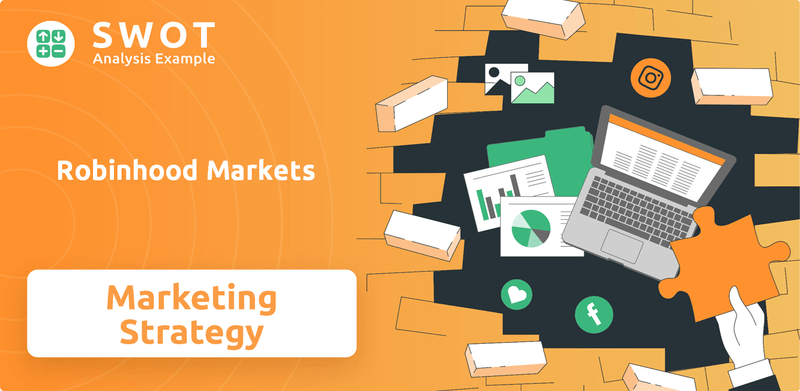
Understanding Robinhood's Robinhood Markets SWOT Analysis is crucial to grasp its sales and marketing evolution. This piece will delve into Robinhood's customer acquisition strategies, examining how it attracts new users and maintains its growth trajectory. We'll dissect its digital marketing strategies, including its social media and content marketing approaches, and analyze the effectiveness of its referral program. Furthermore, we'll explore Robinhood's brand-building strategies and its competitive advantages in marketing, providing a comprehensive market analysis of its sales funnel optimization and marketing budget allocation.
How Does Robinhood Markets Reach Its Customers?
The core of the Robinhood sales strategy revolves around its digital-first approach. The company primarily uses its mobile app and website as direct sales channels, offering commission-free trading in stocks, ETFs, and cryptocurrencies. This direct-to-consumer (DTC) model has been a key factor in its success, eliminating the need for traditional sales teams and physical branches.
Robinhood's marketing strategy centers on continuous platform enhancements to attract and retain users. For instance, the launch of 'Robinhood Legend,' a desktop trading platform, in October 2024, demonstrates its commitment to providing advanced trading tools. The platform has since added numerous indicators and rolled out crypto trading, enhancing its appeal to active traders.
Beyond its core offerings, Robinhood expands its sales channels by diversifying its product suite. This includes premium subscription services such as Robinhood Gold, which had 3.2 million subscribers in Q1 2025, reflecting a 90% year-over-year increase. The introduction of the Robinhood Gold Credit Card in 2024, which had over 100,000 cardholders by the end of 2024, further widened its product distribution.
Robinhood's primary sales channels are its mobile app and website, offering commission-free trading. The company continuously enhances these digital platforms, such as the 'Robinhood Legend' desktop trading platform launched in October 2024. The expansion into premium services like Robinhood Gold and the Gold Credit Card broadens its sales offerings.
Robinhood's growth strategy includes strategic partnerships and acquisitions to expand its reach. The agreement to acquire TradePMR in November 2024, with over $40 billion in assets under administration, aims to enter the investment advisory space. The acquisition of Bitstamp in June 2024 expands its crypto access.
Robinhood is moving towards omnichannel integration by introducing wealth management services with 'Robinhood Strategies' for Gold customers. The planned launch of 'Robinhood Banking' in late 2025 aims to deepen customer relationships and expand revenue streams. These initiatives support its business model.
Robinhood's marketing campaigns analysis reveals a focus on user acquisition and retention through platform enhancements and new product offerings. The referral program effectiveness and social media marketing strategy play a role in attracting new users. The company's user experience and marketing efforts are key to its digital marketing strategies.
Robinhood's primary sales channels are its mobile app and website, offering commission-free trading. The company's user acquisition strategy includes platform enhancements and new product offerings.
- Direct-to-consumer (DTC) digital approach.
- Expansion through premium subscription services like Robinhood Gold.
- Strategic acquisitions, such as TradePMR and Bitstamp.
- Omnichannel integration with wealth management and banking services.
- Focus on user experience and digital marketing strategies.
Robinhood Markets SWOT Analysis
- Complete SWOT Breakdown
- Fully Customizable
- Editable in Excel & Word
- Professional Formatting
- Investor-Ready Format
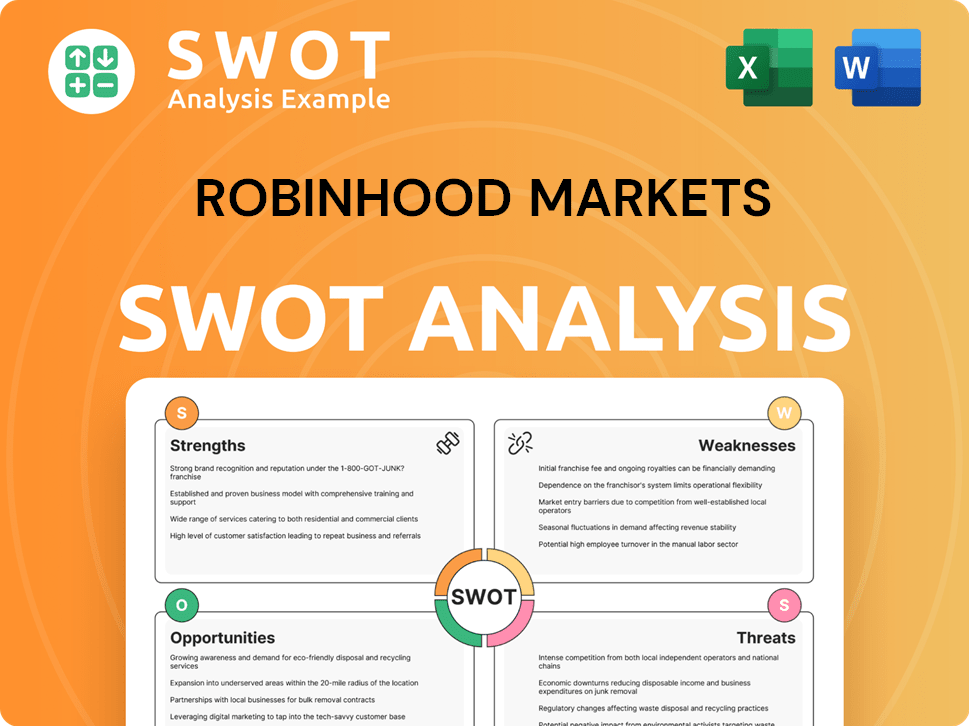
What Marketing Tactics Does Robinhood Markets Use?
The marketing tactics employed by Robinhood are a blend of digital strategies and strategic partnerships, designed to boost brand awareness, generate leads, and drive sales. Their approach is data-driven, using advanced analytics to understand user behavior and personalize marketing efforts. This strategy has been pivotal in their growth strategy, helping them to attract and retain a large user base.
Robinhood's marketing strategy leverages various digital channels, including content marketing, social media, paid advertising, and email marketing. They also utilize influencer partnerships and referral programs to expand their reach. This multi-faceted approach allows them to engage with potential users across different platforms and tailor their messaging to specific audience segments.
A key focus for Robinhood is user acquisition. They have successfully used a combination of strategies to attract new users, including content marketing to educate and inform, social media to build community, and referral programs to incentivize existing users. This has been effective in driving both user acquisition and overall growth.
Robinhood provides educational content, such as investing guides, market updates, and financial tips through its blog, podcasts, webinars, and videos. This positions them as a trusted source of information.
They heavily leverage platforms like Facebook, Twitter, and Instagram for community engagement, sharing informative content, and interacting with customers. This boosts their social media marketing strategy.
Paid advertising campaigns are utilized to reach a wider audience and drive traffic to the platform. This is a part of their digital marketing strategies.
Robinhood collaborates with financial and FinTech bloggers and influencers to promote the platform, leveraging their credibility and reach. This is a key aspect of their marketing campaigns analysis.
Advanced analytics are used to track user behavior, segment customers, and personalize marketing messages and campaigns. This helps optimize their sales funnel optimization.
Referral programs incentivize existing users to refer new ones by offering rewards to both parties. This has been a significant growth catalyst.
Robinhood's marketing tactics are designed to attract and retain users, focusing on digital channels and strategic partnerships. Their approach includes content marketing, social media engagement, paid advertising, influencer partnerships, and data-driven marketing. These tactics are central to their Robinhood sales strategy.
- Content Marketing: Educational content like investing guides and market updates helps position Robinhood as a trusted source.
- Social Media: Platforms like Facebook, Twitter, and Instagram are used for community engagement and customer interaction.
- Paid Advertising: Campaigns are used to reach a wider audience and drive traffic.
- Influencer Partnerships: Collaborations with financial influencers promote the platform.
- Data-Driven Marketing: Advanced analytics track user behavior to personalize marketing messages.
- Referral Programs: Incentivizing existing users to refer new ones.
- Traditional Media: Use of linear TV and radio ads, particularly for Robinhood Gold.
- Sports Marketing: Partnerships with sports teams, such as NBA teams, to increase brand visibility.
Robinhood Markets PESTLE Analysis
- Covers All 6 PESTLE Categories
- No Research Needed – Save Hours of Work
- Built by Experts, Trusted by Consultants
- Instant Download, Ready to Use
- 100% Editable, Fully Customizable
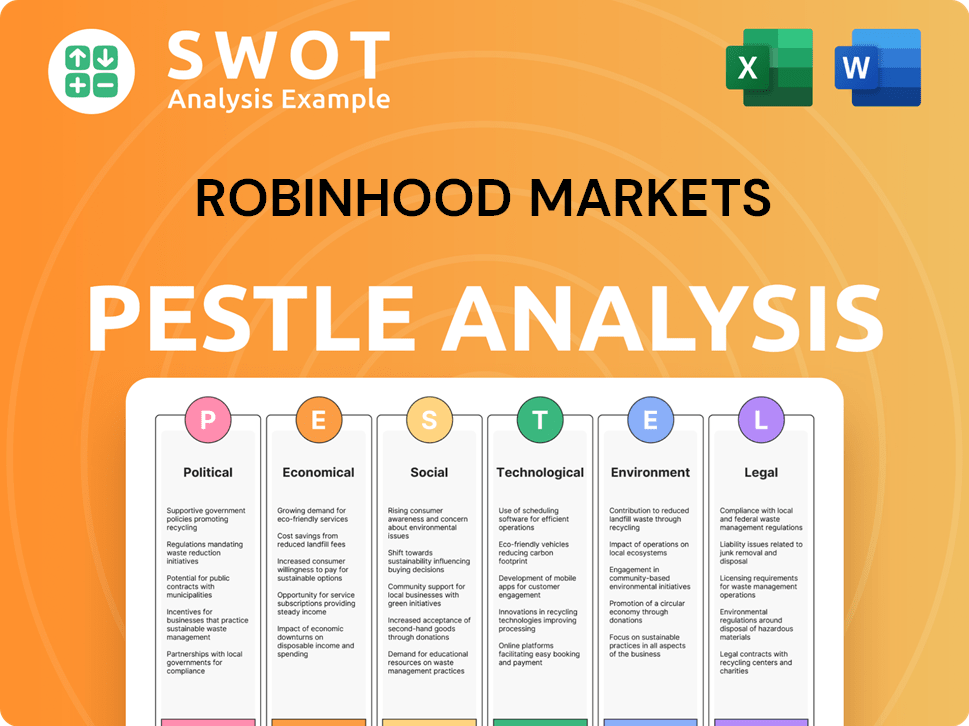
How Is Robinhood Markets Positioned in the Market?
The core of Robinhood's brand positioning revolves around its mission to 'democratize finance for all.' This commitment aims to make investing accessible to a wide audience, irrespective of their financial background or wealth. The company differentiates itself through commission-free trading and a user-friendly mobile application, directly appealing to a broad spectrum of investors.
Robinhood's marketing strategy targets millennials, Gen Z, first-time investors, and active traders. By promising simplicity, affordability, and empowerment in managing their finances, Robinhood has successfully carved a niche in the competitive brokerage market. This approach is central to its Robinhood sales strategy and overall Robinhood marketing strategy.
In late 2024, Robinhood undertook a significant rebrand, signaling a shift from a 'scrappy disruptor' to a more 'sophisticated and focused' financial platform. This evolution aims to attract a broader base of serious investors while retaining its accessibility. The rebrand, developed in partnership with Porto Rocha, included visual identity changes, such as a minimalist design and the introduction of 'Robin Neon' yellow-green, to maintain brand consistency across all its products and marketing touchpoints.
Robinhood primarily targets millennials and Gen Z, as well as first-time investors and active traders. This demographic is attracted by the platform's ease of use and commission-free trading. Understanding the Target Market of Robinhood Markets is key to the company's marketing efforts.
The commission-free trading model has been a major competitive advantage, forcing competitors to follow suit. Robinhood's user-friendly app and focus on accessibility have further solidified its position in the market. This approach is a core element of its Robinhood business model.
The rebrand, launched in late 2024, aimed to evolve the brand image to appeal to a broader investor base. This included a shift to a more sophisticated visual identity, with a minimalist design and a refined color palette. This is part of the Robinhood growth strategy.
Robinhood has shown a strong financial comeback in 2024, indicating the effectiveness of its strategies. The company's focus on rebuilding trust and expanding its offerings has contributed to its positive financial performance. Recent market analysis shows positive trends.
Robinhood's brand identity is built on several key elements that contribute to its market positioning.
- Accessibility: Making investing simple and available to everyone.
- Affordability: Commission-free trading as a core offering.
- User-Friendliness: A mobile-first, intuitive platform.
- Empowerment: Providing tools and resources for financial management.
Robinhood Markets Business Model Canvas
- Complete 9-Block Business Model Canvas
- Effortlessly Communicate Your Business Strategy
- Investor-Ready BMC Format
- 100% Editable and Customizable
- Clear and Structured Layout
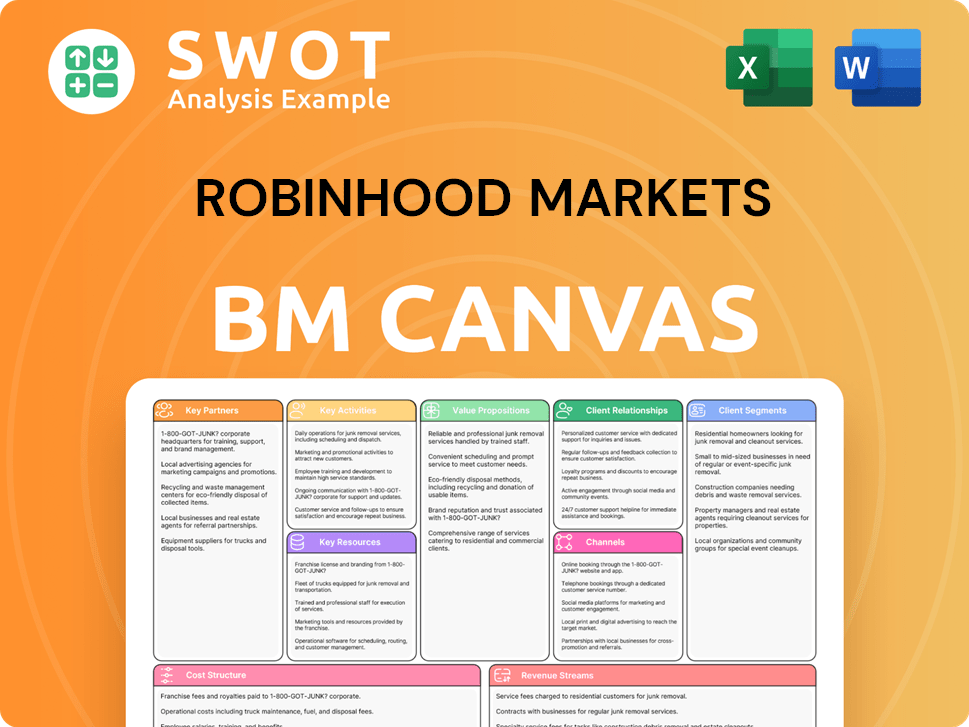
What Are Robinhood Markets’s Most Notable Campaigns?
One of the most impactful early strategies for gaining users was the pre-launch waitlist. This approach utilized FOMO marketing, generating over a million sign-ups before the app's official launch. This early success highlights the effectiveness of creating anticipation and leveraging referral incentives to foster rapid growth, a key element of the company's initial Robinhood sales strategy.
More recently, the company launched its Robinhood Gold campaign in November 2023. This campaign, developed with agency partner AKQA, aimed to boost awareness of the Gold service, boost sign-ups for the premium subscription, and highlight its benefits. The campaign focused on showcasing the premium interest rates and products available to Gold members, typically reserved for high-net-worth clients. This is a core element of the Robinhood marketing strategy.
In late 2024, the firm announced a multi-year partnership with the NBA, prominently featuring its updated logo on the jerseys of the Memphis Grizzlies and Miami Heat. This collaboration aims to expand the company's reach to new audiences and strengthen its brand visibility beyond its digital channels. These campaigns are crucial for the company's Robinhood business model.
The pre-launch waitlist campaign was a critical early success. It effectively created excitement and anticipation, resulting in a massive initial user base. The viral growth loop, driven by user referrals, significantly contributed to the company's initial Robinhood user acquisition.
Launched in November 2023, this campaign focused on promoting the benefits of Robinhood Gold. The multi-channel approach, developed with AKQA, aimed to increase subscriptions. This campaign contributed to a 90% year-over-year increase in Gold subscribers, reaching 3.2 million in Q1 2025.
The multi-year partnership with the NBA, announced in late 2024, features prominent logo placements on team jerseys. This collaboration aims to expand brand visibility and reach new demographics. While direct sales lift from these partnerships isn't always detailed, such partnerships are key for brand exposure.
Referral programs have been a consistent element in the company's growth strategy, encouraging existing users to invite others. This strategy is a direct element of the company's Robinhood growth strategy. These programs often provide incentives to both the referrer and the new user, creating a powerful network effect.
The company's marketing efforts are carefully aligned with its business objectives and Robinhood market analysis. For more information on the company's ownership and financial structure, explore Owners & Shareholders of Robinhood Markets.
Robinhood Markets Porter's Five Forces Analysis
- Covers All 5 Competitive Forces in Detail
- Structured for Consultants, Students, and Founders
- 100% Editable in Microsoft Word & Excel
- Instant Digital Download – Use Immediately
- Compatible with Mac & PC – Fully Unlocked
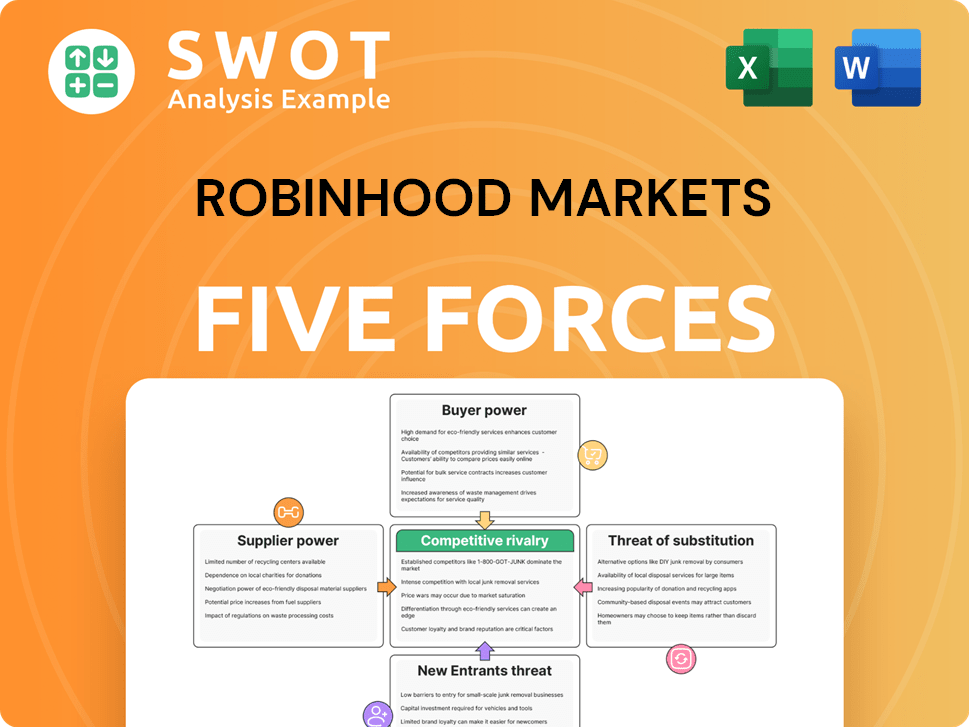
Related Blogs
- What are Mission Vision & Core Values of Robinhood Markets Company?
- What is Competitive Landscape of Robinhood Markets Company?
- What is Growth Strategy and Future Prospects of Robinhood Markets Company?
- How Does Robinhood Markets Company Work?
- What is Brief History of Robinhood Markets Company?
- Who Owns Robinhood Markets Company?
- What is Customer Demographics and Target Market of Robinhood Markets Company?
Disclaimer
All information, articles, and product details provided on this website are for general informational and educational purposes only. We do not claim any ownership over, nor do we intend to infringe upon, any trademarks, copyrights, logos, brand names, or other intellectual property mentioned or depicted on this site. Such intellectual property remains the property of its respective owners, and any references here are made solely for identification or informational purposes, without implying any affiliation, endorsement, or partnership.
We make no representations or warranties, express or implied, regarding the accuracy, completeness, or suitability of any content or products presented. Nothing on this website should be construed as legal, tax, investment, financial, medical, or other professional advice. In addition, no part of this site—including articles or product references—constitutes a solicitation, recommendation, endorsement, advertisement, or offer to buy or sell any securities, franchises, or other financial instruments, particularly in jurisdictions where such activity would be unlawful.
All content is of a general nature and may not address the specific circumstances of any individual or entity. It is not a substitute for professional advice or services. Any actions you take based on the information provided here are strictly at your own risk. You accept full responsibility for any decisions or outcomes arising from your use of this website and agree to release us from any liability in connection with your use of, or reliance upon, the content or products found herein.